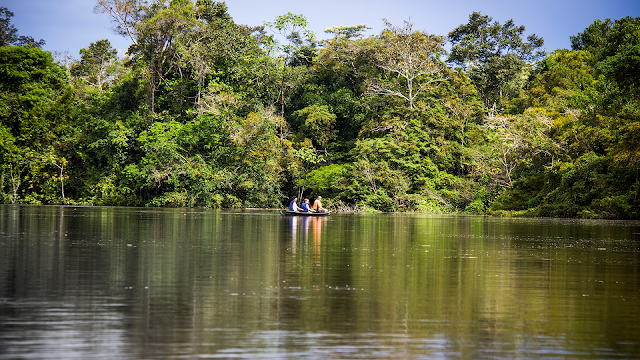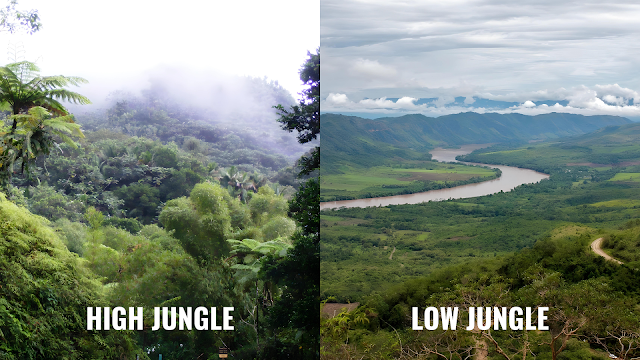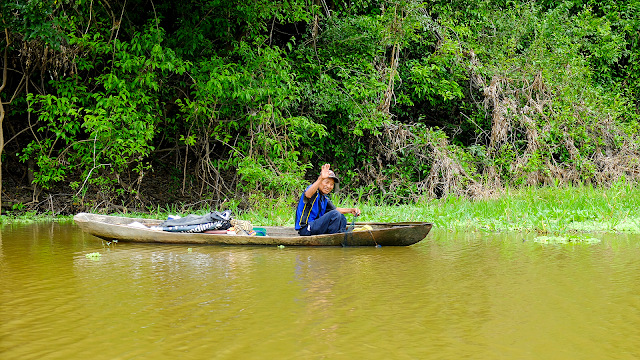The Peruvian Amazon is simply amazing, with a variety of Mountains, Rivers and Valleys, as well as wildlife and lush vegetation; In this guide to the heart of the Amazon Peru we will delve to discover its mysteries, and explore its forests. So join us on this journey of wonder and discovery, as we unravel the hidden wonders that make the Amazon a sanctuary of life and beauty.
Discovering the Topography of the Peruvian Amazon
Although the Peruvian Amazon contains one of the most diverse and amazing topographies ever seen, it makes adventurers and people interested in the jungle explore this fantastic place. From the high mountains of the Andes to the meandering rivers that cross the various valleys of Peru, each corner offers a unique landscape and the Amazon Rainforest is no exception, with geographical variability creating a vivid and exciting environment, offering an unforgettable trip. through the hidden wonders of the Peruvian jungle.
Mountains, Rivers and Valleys: The Variety of Geography
The Amazon Rainforest, located to the east of the Andes Mountains, spans an extensive area of 782,880 km² and is renowned for being one of the regions with the highest biodiversity and endemism in the world, covering more than 60% of Peru. Likewise, its relief is almost uniform and is made up of a long and extensive arid plain, in which there are small valleys, alluvial plains and low mountains; In addition, the Peruvian Forest is also characterized by having high rainfall and is mostly occupied by a tropical humid forest, which represents more than 56% of the world's total broadleaf forests (also called humid tropical forests or jungles, they are forest formations that are made up of various species of broadleaf trees).

Exploring Ecosystem Diversity
The Peruvian Amazon contains a surprising diversity of ecosystems, of this total it can be said that approximately 80% of the Amazon territory is forests and 20% is water (rivers, lakes, aguajales, among others). Likewise, in the Peruvian jungle there are two levels or regions: The high jungle and the low jungle, and in each of these habitats a unique variety of flora and fauna is presented, offering a unique exploration experience. Likewise, the richness of Amazonian biodiversity is manifested in every corner, from the dense vegetation of the jungle to the open areas that reveal the amazing interconnection of these ecosystems.
Curious Facts about the Amazon Rainforest
The Amazon is the largest ecosystem in the world, since it contains a large amount of flora and fauna in the world, its large trees are responsible for removing CO2 from the air, absorbing bad odors and polluting gases at the same time. Likewise, the high temperatures of the Amazon rainforest favor the development of dense and exuberant vegetation, always with that pigmentation characterized by an intense green; Furthermore, some of the Amazon rainforest Peru is home to a variety of wildlife, such as jaguars, sloths, river dolphins, macaws, anacondas, glass frogs, and poison dart frogs. Last but not least, the Amazon River, the largest and longest river in the world, obtained ranking 4 and was recognized as a local resource of great significance for international tourism, adding to the Historical Sanctuary of Machu Picchu, the lines and the geoglyphs from Nasca.
Cultural and Historical Curiosities
Exploring the Peruvian Amazon means entering a world full of culture and history, in which numerous indigenous tribes that have inhabited the region for centuries, carry in their cultures the most fascinating stories and ancestral rituals passed from generation to generation. So, discover how these communities have preserved their cultural heritage, using traditional methods and celebrating unique and representative festivities that reveal the deep connection between people and the jungle.
Between Rain and Sun: The Tropical Climate
The tropical climate of the Peruvian Amazon shapes a changing scenario that offers two different faces in each season, it is characterized by being warm and humid throughout the year, with abundant rains and high temperatures, which benefits the vegetation areas. tropical area of the Amazon River basin, where the largest nature reserves are located. So, from the rainy season that transforms the jungle into a bountiful garden to the dry season that reveals more open landscapes, each season offers a different experience.
Seasons and Climate Temperatures
The Peruvian Amazon enjoys a tropical climate that is divided into two main seasons: the rainy season and the dry season. During the rainy season, rivers overflow, creating lush landscapes and an explosion of life; while in the dry season, the jungle exhibits a different look, revealing sandy beaches and a vibrant color palette. On the other hand, with respect to temperatures, it has two seasons: summer (April - October), with sunny days, cold nights and little rain, this makes it an ideal time to visit and explore the jungle, since the temperature reaches up to 24 °C and at night it can drop to 0 °C; Then we have winter (November - March), in which there is abundant rain and the temperature ranges between 15 and -3°C, therefore it is not recommended to travel during these dates.
Microclimates and Atmospheric Phenomena
In general, Peru has 38 climate types, according to Warren Thornthwaite's Climatic Classification method, as a result of the interaction between the different climatic factors that affect it and its geographical position in the tropics, to the Andes mountain range, forging a complex physiography.
But as for the Peruvian Amazon rainforest, it has a rich climatic variety and a notable diversity of ecoregions, so it does not have a uniform climate, but instead houses a variety of microclimates, so at the same time we can find areas with showers. and others with radiant sun and as has been said, this diversity is due to the complex topography and the influence of rivers. On the other hand, these types of microclimates are due to the ecoregions and seasons that make the jungle a unique and peculiar place.
Ecoregions:
The region is divided into two distinct ecoregions:
- Low Jungle: It is located in the lowest areas, between 80 and 800 meters of altitude. A warm and humid climate prevails, with average temperatures of 28°C and humidity of 75%.
- High Jungle: It is located on the eastern slopes of the Andes, between 400 and 1,000 meters of altitude. Temperatures are slightly cooler than in the Selva Baja, with an average of 23°C.
Seasons:
The year is divided into two seasons:
- Wet season: It extends from November to April and concentrates 80% of the annual rains. Temperatures range between 17°C and 32°C, with some occasional drops to 7°C.
- Dry season: It runs from May to October and is characterized by a lower volume of rain. Temperatures are warmer, averaging 25°C.
The Emblematic Fauna in the Peruvian Jungle
The lush wildlife of the Peruvian Amazon flourishes in its extensive forests and rivers, hosting a diverse fauna that includes jaguars, sloths, river dolphins, macaws, anacondas, glass frogs and poison dart frogs. Therefore, it is estimated that approximately one in ten known species in the world makes its home in this region, as well as one in five bird species identified globally. This makes it one of the areas with the greatest biological diversity on the planet, suggesting that much of this biological wealth still remains undiscovered and without exhaustive study. Therefore, in terms of avian biodiversity, Peru occupies second place worldwide, only surpassed by Colombia, and is positioned in third place in terms of mammals, with a notable 44% and 63%, respectively, that have their habitat in the Peruvian Amazon.
The Lush Vegetation of the Amazon
The flora of the jungle is manifested through its vast tropical forests, where an innumerable variety of tree species, which vary in quality of wood or useful resins, coexist with palm trees and orchid plants (among the species present the Cattleya gaskelliana stands out or cinchona tree). Furthermore, the Amazon biome mainly encompasses areas covered by dense humid tropical forests, with small portions of other types of vegetation, such as savannahs, floodplain forests, grasslands, swamps, bamboo and palm forests, so in a single hectare of rainforest, you can find up to 42,000 different species of insects, 807 trees belonging to 313 species and 1,500 species of higher plants.
Botanical Diversity
In the Peruvian Amazon jungle, it stands out that of the 182 species of native plants domesticated in the country, 85 belong to the Amazon region and of the 4,400 plants used for 49 multiple purposes, approximately 3,000 are also native to the Amazon (as additional information , Peru has 782 species of food plants, 70% of them being part of the Amazonian flora). Now, what is the importance of biodiversity in the Amazon? Amazonian biodiversity plays a crucial role in global systems, influencing the global carbon cycle and, therefore, climate change. It also affects hydrological systems at the hemispheric level, being a fundamental pillar for climate and precipitation in South America.
Medicinal plants
The Amazon rainforest has contributed dozens of substances to Western medicine, among the best known are curare, a fundamental component of modern anesthetics, and quinine, the first contribution of “natural medicine” to treat a particular disease, malaria. Therefore, thanks to its biological wealth, the Peruvian Amazon jungle is known for its valuable medicinal plants, which local communities have used wisely for generations to treat various ailments and maintain their health in good condition. Some of them are the following:
- Cat's Claw: Climbing shrub from the Amazon with medicinal properties. Its bark is used in infusions to treat various ailments such as rheumatism, biliary colic and snake bites.
- Dragon's blood: Amazonian tree whose resin cures internal and external diseases. It has healing, anti-inflammatory, antiviral and antibacterial properties, relieving bites, mouth sores and gastric ulcers.
- Chanca piedra: Plant from the Peruvian Amazon with benefits for the immune system. It is used to treat hepatitis, urinary infections and as a diuretic. It is also effective against kidney problems, spasms, inflammation and fever.
- Copaiba: Tree from Brazil and Peru whose oil has diuretic, expectorant and disinfectant properties. Used in dermatological and broncho-pneumatic treatments, it should be used with caution.
- Sour cane: Loreto and Madre de Dios plant with anti-inflammatory properties. It contributes to the treatment of respiratory diseases and other ailments such as conjunctivitis and hepatitis.
- Huayruro: Tree from the Loreto region with seeds used in infusions for sitz baths in the treatment of hemorrhoids.
- Guaraná: Plant with invigorating, rejuvenating and aphrodisiac properties. Found in the Amazon of Brazil, Peru, Colombia and Venezuela, it can be consumed as a tea, juice or smoothie to strengthen the heart, muscles and improve circulation.
Amazon Trails: Unforgettable Tours in the Peruvian Jungle
Exploring the Peruvian Amazon through its trails is an entertaining and relaxing experience, so much so that you will forget about the annoying hustle and bustle of the city and just feel the wind and enjoy the beautiful Amazonian landscape. From hiking through lush flora to embarking on exhilarating canoe excursions along the winding rivers of the Amazon, each trail offers a unique perspective. But you will not be alone, since you will have expert local guides who share knowledge about the flora, fauna and history of the jungle, these tours become unforgettable journeys of discovery. And since we're talking about tours, here we present some of the amazon tours peru that might interest you:
2. Inca Trail and Amazon Jungle Tour
3. Inca Trail, Lake Titicaca and Amazonia
4. Inca Trail to Amazon Rainforest Tour
5. Inca Trail, Titicaca Travel & Amazon Tours Peru











Comments
Post a Comment